17 Engagement Ring Styles and Settings You Should Be Considering
Helping you find the best engagement ring style to fit your style.
Helping you find the best engagement ring style to fit your style.
Your choice of engagement ring setting and style is extremely important. It’s the first decision you should make in the process as it will determine to some extent what kind of diamond you’ll need to buy.
Setting refers to how gemstones are set, or mounted, into a band, playing an important role in highlighting the beauty of the diamond. For instance, a prong setting uses metal claws to hold the diamond, while a bezel setting encircles the diamond with metal. On the other hand, style denotes the overall design theme enhanced by the ring’s setting. Whether it’s the singular focus of a solitaire, the radiant circle of a halo, or the symbolic trio of a three-stone design, style gives the ring its unique character and narrative.

Some examples of popular styles and settings are:
Settings:
Styles:
When selecting your setting and style keep in mind the metal you prefer, the color of the gold, and your lifestyle. For example an active lifestyle that requires a lot of work with the hands may benefit from setting with more prongs or a halo style.
Current Engagement ring trends
Details about the most popular settings and styles
Why you should trust us
Engagement ring styles can vary hugely in appearance and personality. For example, look at this solitaire ring from Blue Nile, then compare it to this rollover halo engagement ring from Blue Nile. Despite being made from the same metal, the style of these two rings couldn’t be more different — with different price tags to match.
Luckily, working out the best engagement ring style for your fiancé-to-be isn’t as difficult as it first seems. This is because each engagement ring style has its own unique advantages and disadvantages.
For example, some styles are light, simple and elegant, making them great choices if your fiancé-to-be likes simple, timeless beauty. Others are more eye-catching and decorative, with pavé or halo diamonds and engraving to add to the ring’s beauty. Finally, others are designed with durability in mind, making them great for busy, active people or those who work with their hands.
The JCK Show in Las Vegas is the industries largest event of the year. The event typically held in June includes a peak into the upcoming trends in the jewelry for the coming year. As reported in The Diamond Talk some of what we enjoyed in 2022/2023 included a focus on “Tranquility, Balance, Euphoria, Spontaneity, Inner Strength, and Optimism” Look for top engagement and wedding ring brands to be highlighting these in their creations.
Below, we’ve listed the 17 most popular engagement ring styles, complete with information on each style’s biggest strengths and weaknesses. We’ve also provided links to samples of each setting type to help you look through the variety of options that are available.
Rather than focusing on metals (such as white, yellow or rose gold, or other options such as platinum), our list focuses on specific engagement ring designs. Most of the rings featured below can be customized with your choice of metal after you click through to James Allen or Blue Nile, giving you a huge degree of control over their appearance.
Of course, you can also customize each ring with your choice of diamond or center stone as well.
Whether it’s an engagement ring and your first-time diamond purchase, or simply a gift for a loved one, we present to you our guide to ring settings, complete with definitions and photos for each term.
Once you settled on the right setting, contact us and we’ll be happy to pick the perfect diamond for you.
Click the style you are interested in to jump ahead to that section.
(Click Here for Samples on Blue Nile)
The most common and classic ring setting is called a prong setting. A prong is a little metal claw that grips the diamond tightly, holding it in place. Prongs can be rounded, pointed, flat, or V-shaped (the latter being the most common for princess-cut diamonds).
Most prong settings feature either four or six prongs; with the former, you can see more of the diamond, but the latter is more secure. A benefit of this setting is that there is a minimum presence of metal so that there’s more diamond to see and more light that can pass through the diamond, thus adding to its brilliance.
Pros of a Prong Setting
Cons of a Prong Setting
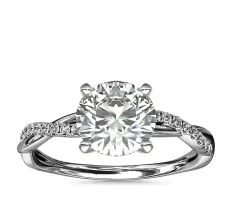


Of the prong settings, the most common is the solitaire setting featuring one diamond or other precious stone. The solitaire setting draws all of our attention to the stone with little to distract us like other stones or fancy metalwork. Check out the best solitaire engagement rings here.
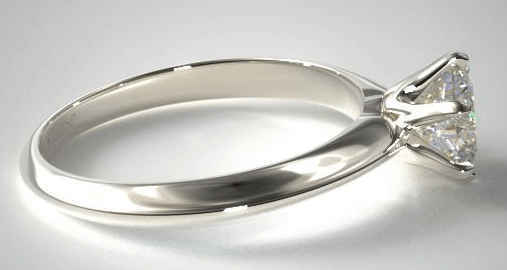
(See Similar Sample on Blue Nile)
In 1886, Tiffany & Co. scientifically developed a specific solitaire six-prong setting to maximize the light return on the diamond. This plain-band setting has come to be known as “the Tiffany setting,” distinguished primarily by the “knife edge” of its shaft and the design of its prongs.
While it is possible to obtain a similar setting at virtually any jewelry shop or website today, it will never be an exact Tiffany setting because Tiffany has trademarked their prong design.
Pros of a Tiffany Setting
Cons of a Tiffany Setting
We’ve created an article with some of our favorite Tiffany look-alikes for you to check. These rings are gorgeous and equal in quality to what you’ll find at Tiffany. We’ll let you decide how much the status of the “little blue box” is worth to you.
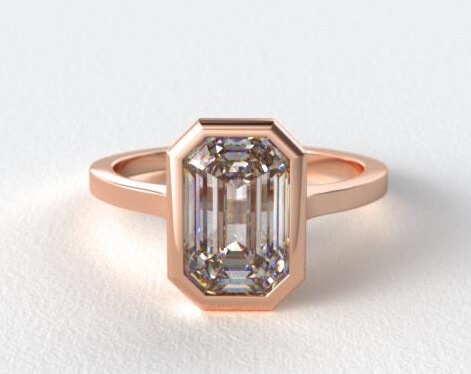
(Click Here for Samples on James Allen)
The bezel setting is the second most popular ring setting due to its modern look and suitability for an active lifestyle. Instead of holding the diamond with prongs, the bezel setting encircles the diamond, or center stone, with a thin metal rim custom-made to hold the stone tightly in place.
Because of this bezel, the diamond is held more securely in place than it would be in a ring that uses prongs. This makes the bezel setting one of the most durable of all engagement ring styles.
A bezel setting can be a full or partial setting: a full bezel completely surrounds the diamond whereas a partial bezel leaves the sides open. It’s a great choice for nurses, teachers, and others looking for a ring that won’t snag and will adequately protect the diamond.
Pros of a Bezel Setting
Cons of a Bezel Setting
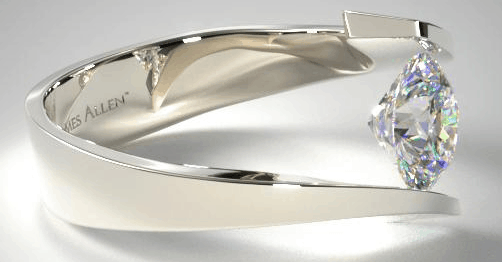
(Click Here for Samples on James Allen)
The tension setting is named for the tension of the metal band that secures the diamond in place; the result is that the diamond appears suspended between the two sides of the shank.
With the help of lasers used to calibrate the exact dimensions of the diamond, the jeweler expertly cuts tiny grooves into the sides of the band, or shank, so that the diamond, or other precious stone, is literally held by the pressure of the custom-designed metal band pushing into the sides of the stone.
Tension-style settings feature a comparable look of diamond suspension but are less expensive and complicated to make. The tension-style settings add an extra dose of security since they employ a prong or bezel setting on the side or underneath the diamond to anchor the diamond firmly in place.
For this type of a setting, it’s extremely important to find a diamond that doesn’t have any visible inclusions because this setting doesn’t have any prongs that could hide them and is exposed from every angle.
Pros of a Tension Setting
Cons of a Tension Setting
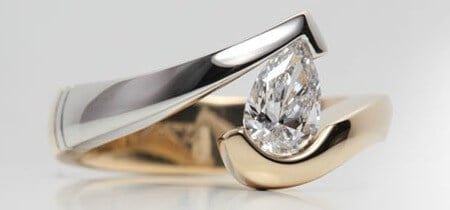
A popular engagement ring style is to mimic a tension style setting (like you see above), but in fact the diamond or gemstone is set in the band, typically as a bezel setting.
The ring in the photo above – two-tone metal with pear shape diamond from James Allen (learn more about mixed metal engagement rings here) is a classic tension setting while the one underneath is a tension-style setting. Notice the bezel setting around the round diamond in the tension-style setting.
Pros of a Tension Style Setting
Cons of a Classic Tension Setting
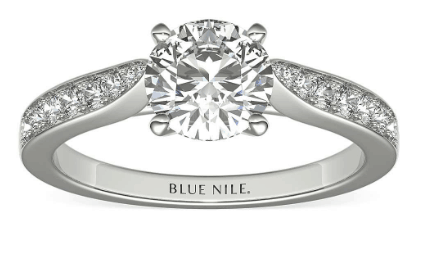
(Click Here for Samples on James Allen)
The channel setting is a secure way to set smaller diamonds in a row into the band of the ring, making a metal channel of sparkling stones flush with the shank.
The diamonds, or other gemstones, are set closely together into the grooves of the channel and decorate the sides of the band or the entire band. This setting is also popular for wedding bands or stackable rings that feature only smaller stones and no center stone.
Since there are no prongs, this setting is also a good option for a snag-free and secure design. In the photo below, the diamonds in the shank are channel-set.
Pros of a Channel Setting
Cons of a Channel Setting
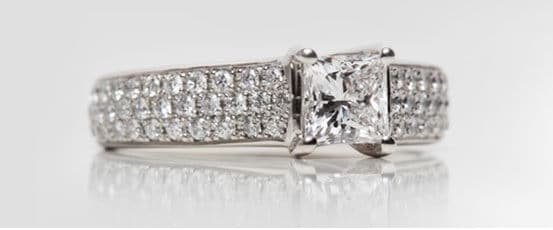
(Click Here for Samples on James Allen or Click Here for Samples on Blue Nile)
The pavé setting, pronounced “pa-vay,” comes from the French word “to pave,” as in paved with diamonds. By closely setting small diamonds together with minimal visibility of the tiny metal beads or prongs holding the stones in place, the effect is one of continuous sparkle.
The jeweler typically drills holes into the ring, carefully places the diamonds into the holes, and finally forms tiny beads, or mini-prongs, around each diamond to secure them into the holes. Look how beautiful a pavé setting can look with an oval diamond.
This setting is also known as a bead setting and in the case of especially small stones, may be called a micro-pavé setting. Diamonds are said to be pavé-set when they are as small as .01-.02 carats and any smaller than that would be called micro-pavé.
Pros of a Pavé Setting
Cons of a Pavé Setting
We recommend confirming ring size early in the design process in order to prevent any problems with fit when the ring is finished.
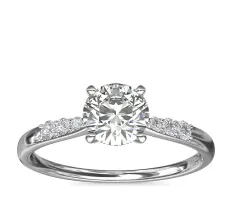
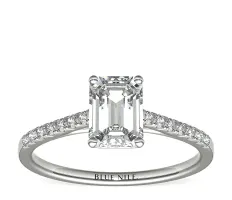
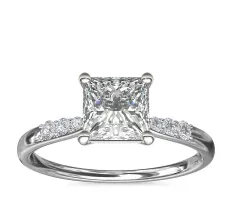
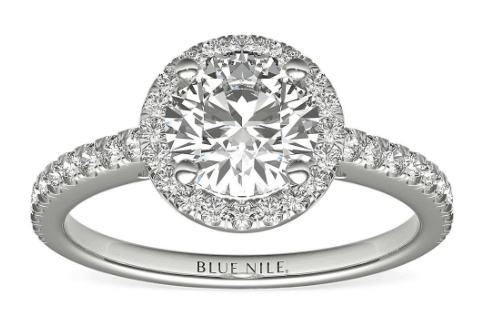
(Click Here for Samples on James Allen)
The halo setting refers to the placement of diamonds or other gemstones in a concentric circle or square around a center stone. The halo setting makes the center stone appear larger—a great option to boost the appearance of a small diamond—and it increases the overall sparkle of the ring. They come in various interesting shapes, some of them even look like flowers.
A halo setting, then, can be a way to save money on a smaller-carat diamond while not sacrificing the overall appearance of the ring. In addition, adding a halo of colored gemstones or setting the halo diamonds with a different color metal can make for a contrast in colors.
Halos are often paired with pavé bands (see example below) but could certainly stand on their own with a simple unadorned band. And as the name implies, a double halo setting consists of two concentric circles of gemstones that encircle the center stone.
Pros of a Halo Setting
Cons of a Halo Setting
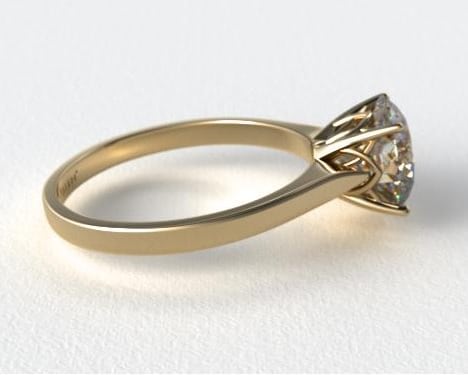
(Click Here for Samples on Blue Nile)
The cathedral setting is one of the most elegant and classic engagement ring settings. Similar to the graceful arches of a cathedral, this ring setting uses arches of metal to hold the diamond or other gemstone.
The cathedral may be set with prongs, bezel or tension setting since the defining characteristic of this ring is not how the diamond is held but rather how it is mounted with arches above the rest of the shank.
The arches can add extra height and make the center stone appear larger; they can also add cost-saving style for less money than adding more diamonds.
Pros of Cathedral Setting
Cons of Cathedral Setting
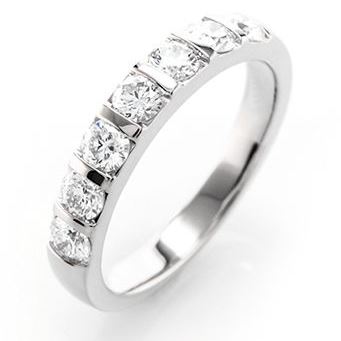
(Click Here for Samples on Brian Gavin)
Setting diamonds separately between vertical bars of metal is another way to set precious stones.
Bar settings are similar to channel settings, but the difference is that channel setting enclose the diamond on all sides whereas the bar setting leaves the diamond exposed on two sides, held in place by the metal bars that secure the stones on the other two sides.
This setting can compliment a center stone or stand alone for an impressive wedding band or stackable ring. See the photo below of a bar-set eternity band.
Pros of a Bar Setting
Cons of a Bar Setting
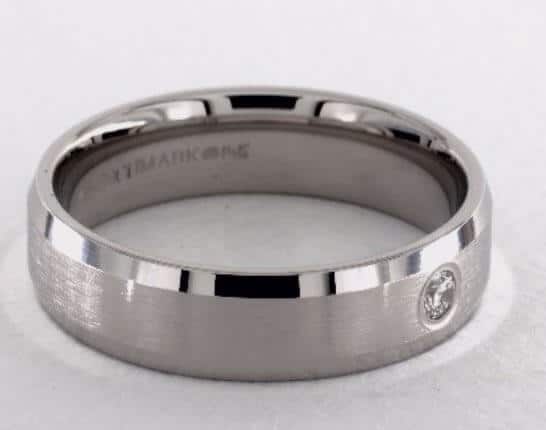
A flush setting, also known as a gypsy setting, sets the diamond into a drilled hole in the band of the ring so that the ring sits “flush” with the band of the ring.
Then the jeweler hammers the metal around the diamond to hold it in place. Because the jeweler must hammer in this piece of metal to hold the stone in place, this setting is not suitable for softer stones, which could crack in the process.
This type of setting is a popular choice for wedding bands, especially men’s wedding bands, as the diamond sits securely in the band of the ring and is therefore highly protected from chipping or falling out. Like the bezel setting, this is one of the most protective and durable engagement ring styles and a great option for people who work with their hands.
Pros of a Flush Setting
Cons of a Flush Setting
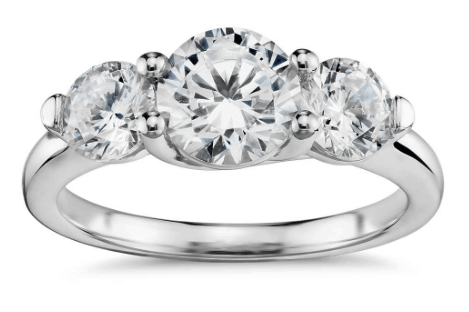
(Click Here for Samples on James Allen)
The three-stone setting is a versatile setting that can be used for engagement, anniversary, or any occasion. The three stones, set closely together, are said to symbolize the couple’s past, present, and future.
These stones can either be all the same size or, as is often the case, the center stone is larger than the two side stones. The most popular diamond shapes for this setting are the round brilliant cut and the princess cut.
It’s possible to personalize this setting with colored sidestones, such as sapphires, rubies, emeralds (see photo below), or other birthstones.
Pros of a Three Prong Setting
Cons of a Three Prong Setting
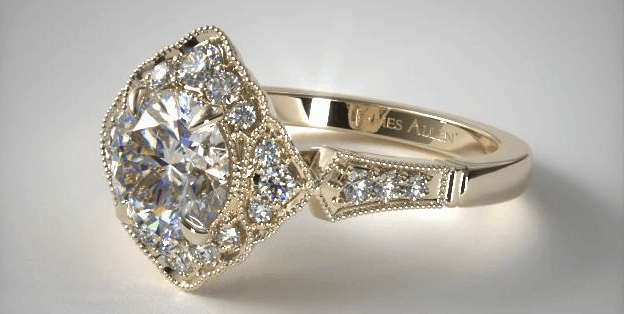
(Click Here for Samples on James Allen)
Many of the antique/vintage engagement ring styles are designed to fit specific time periods of jewelry fashion, such as Art Deco, Edwardian and Victorian era styles. Often these rings feature intricate detail work such as filigree and milgrain.
Filigree is a kind of delicate metalwork that solders together tiny metal beads or twisted threads of metal to the surface of the jewel. And milgrain engraving is a type of embellishment added to antique style rings to give them that “antique” look of tiny balls of metal decorating the sides of the band and the crown of the ring.
Check out the photo above of an antique style setting with tiny yellow gold milgrain embellishments around the halo round brilliant diamonds and repeated on the shank. Check out our guide to the best places to buy a vintage/antique ring here.
Pros of a Vintage Setting
Cons of a Vintage Setting
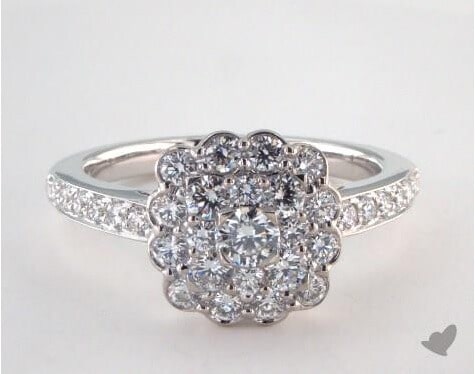
A cluster setting “clusters” stones tightly together in order to look like a large diamond. It can either contain a larger center stone or cluster together stones of equal size.
In the example below, this cluster setting gives the impression of a 1.5 carat center stone, which is far larger than the actual small center stone featured in this ring. James Allen now has a line of cluster settings, called the “Royal Halo Collection.”
Pros of a Cluster Setting
Cons of a Cluster Setting
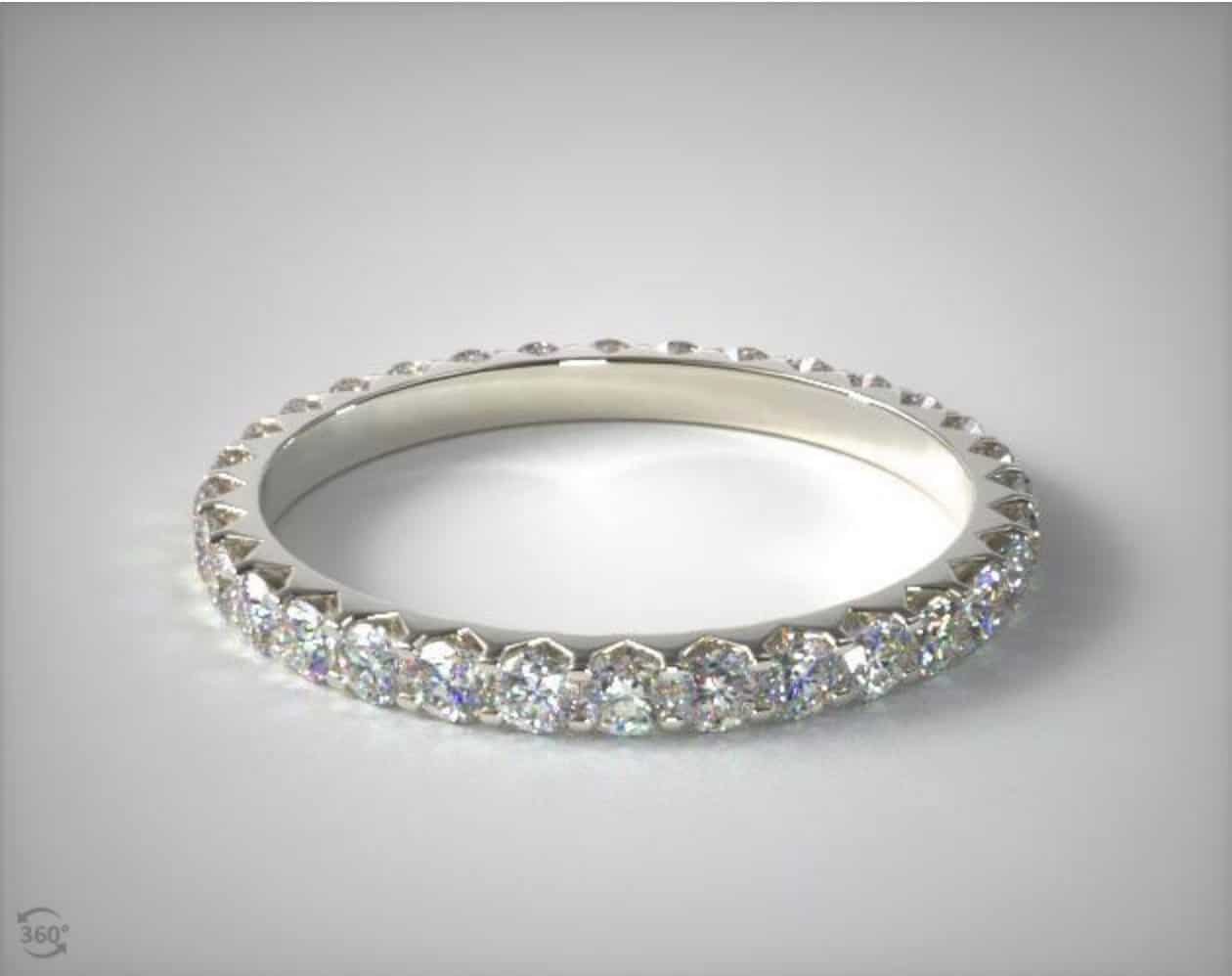
(Click Here for Samples on James Allen)
Eternity bands are not a particular kind of setting per se; rather they are a style of band that is often used for women’s wedding bands or other special occasions such as anniversaries, birthdays and Valentine’s Day.
These bands get their name from the “eternal” presence of diamonds or other precious stones that decorate the entire band of the ring. Eternity rings are available in prong, channel, bezel and flush settings.
Pros of an Eternity Band
Cons of an Eternity Band
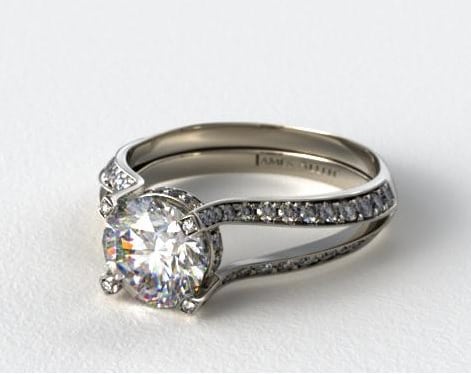
(Click Here for Samples on James Allen)
Here’s another term you may heard thrown around by jewelers. The shank refers to the band of the ring or the part that actually encircles your finger. Most shanks are round, but there are also square shaped-shanks and other more creative shapes.
A split-shank refers to a ring in which the shank splits into two separate shanks. See the example below of this pave-set split-shank band.
Pros of a Shank/Split-Shank Setting
Cons of a Shank/Split-Shank Setting
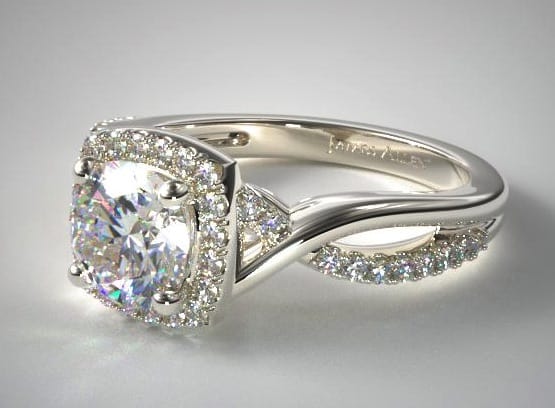
(Click Here for Samples on James Allen or Click Here for Samples on Blue Nile)
Designed to symbolize everlasting love, an infinity setting features a unique, beautiful design with an “8”-shaped pattern made up of two interlinking bands. Together, these bands form an infinity symbol, giving the ring an elegant, graceful appearance that emphasizes the center diamond.
Just like other rings, Infinity engagement ring settings come in a variety of styles. Some are solitaire settings that combine a beautiful center diamond with an unadorned band, while others feature pavé-set diamonds that frame and draw attention to the center diamond. Some infinity settings even combine these designs, such as a “twist” engagement ring from Blue Nile, which features one plain, unadorned band and another with pavé-set diamonds.
Pros of an Infinity Setting:
Cons of an Infinity Setting:
If you’re interested in selecting an exquisite diamond for your ring, get in touch with one of our experts who can help you review diamonds and ensure you’re not overpaying.




Before you buy a diamond, get personal buying advice from industry veterans. We'll help you get the best diamond for the money.
DISCLAIMER: We don't use your email for marketing. Period.
A diamonds’ price is determined primarily by the 4 Cs of the diamond. On the wholesale level, diamond prices are first based on a diamond shape and
Buying an engagement ring is often one of the first major purchases in a person's life. The process can be fraught with tension as there are so m
A wide range of 1 carat diamonds exist both in online markets and local diamond jewelry stores. Not only are there significant differences in beauty
Please enter your email address to receive your 25% off coupon code:
Here is your coupon code: GFDSF3GF